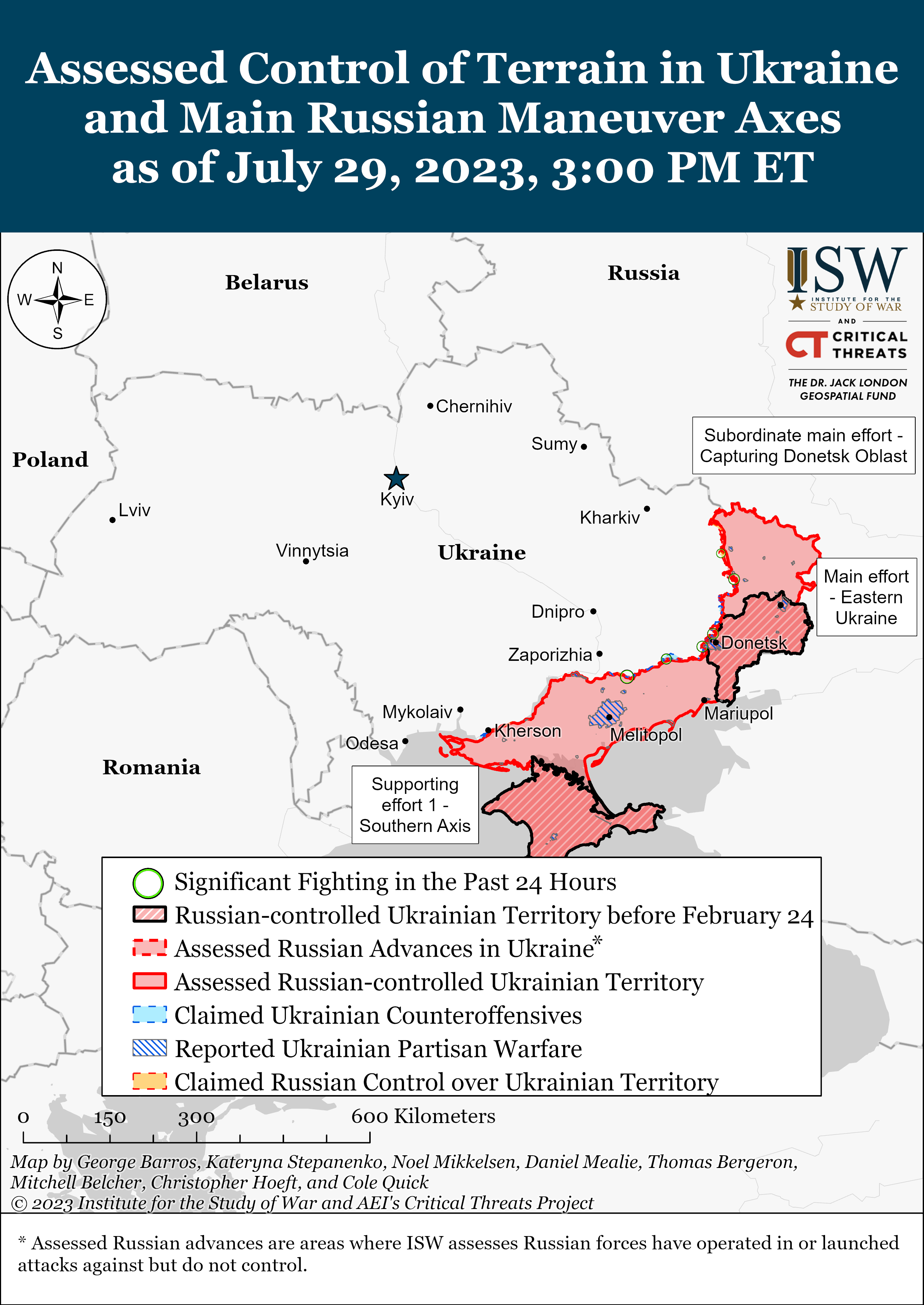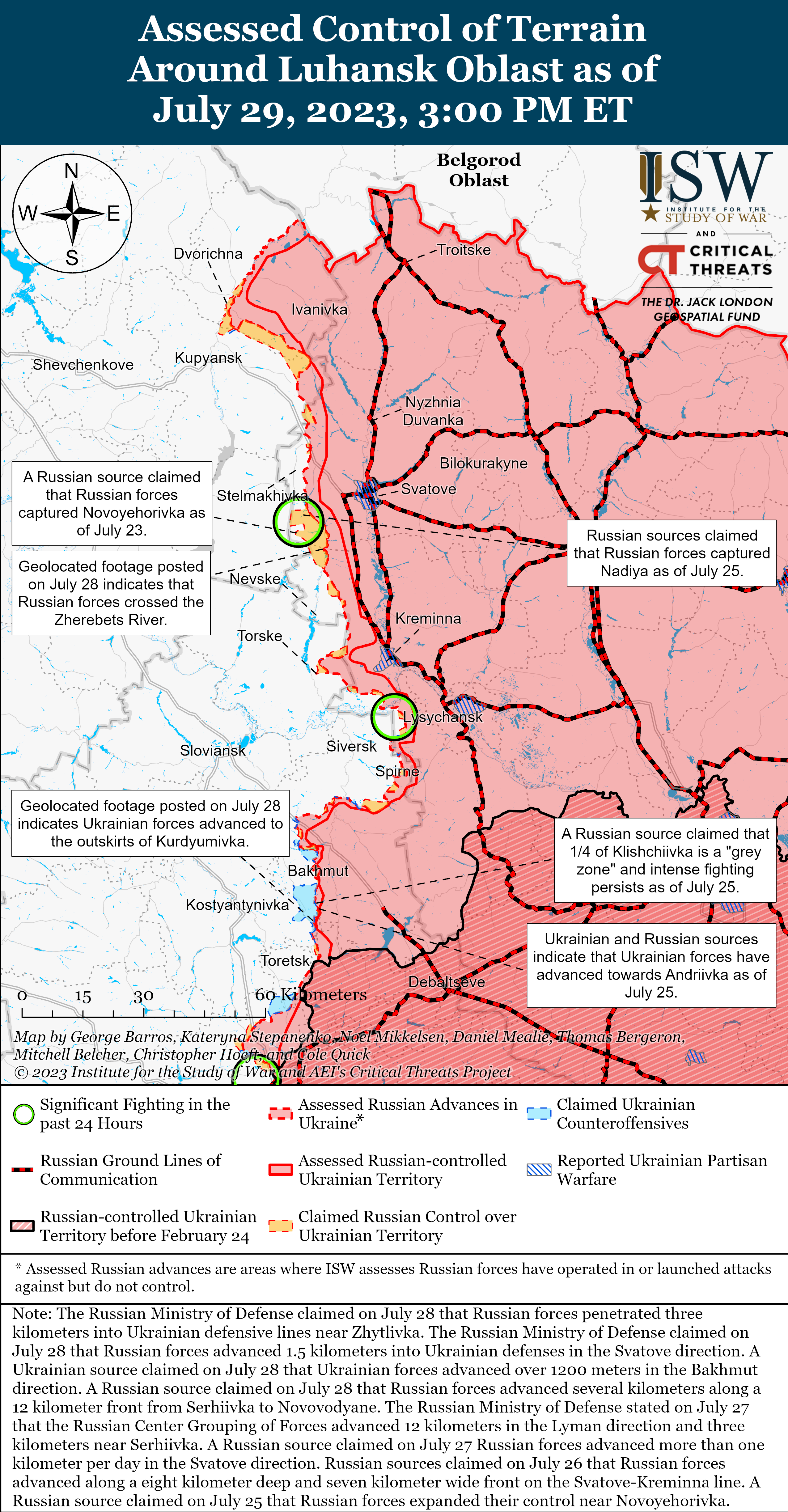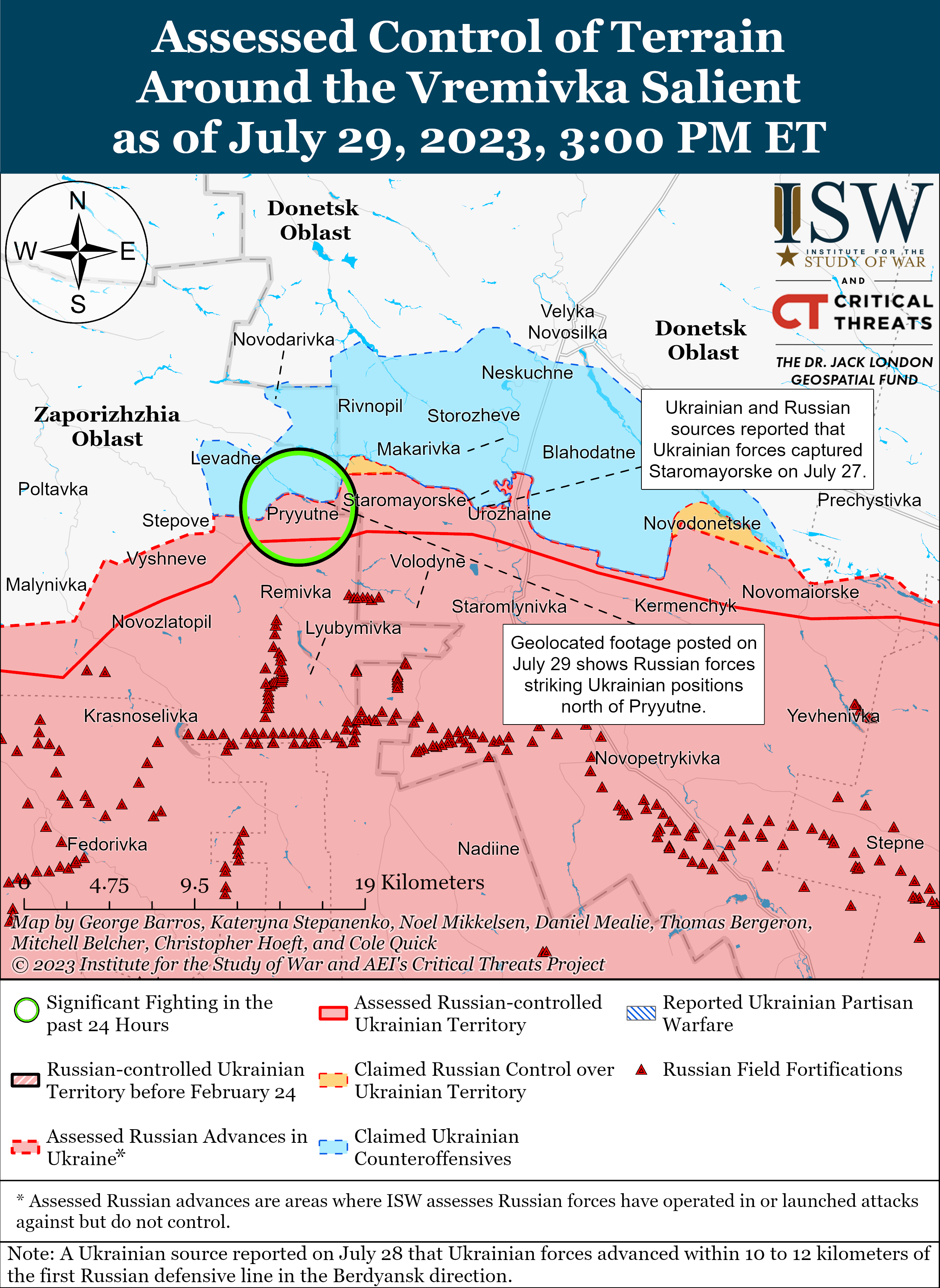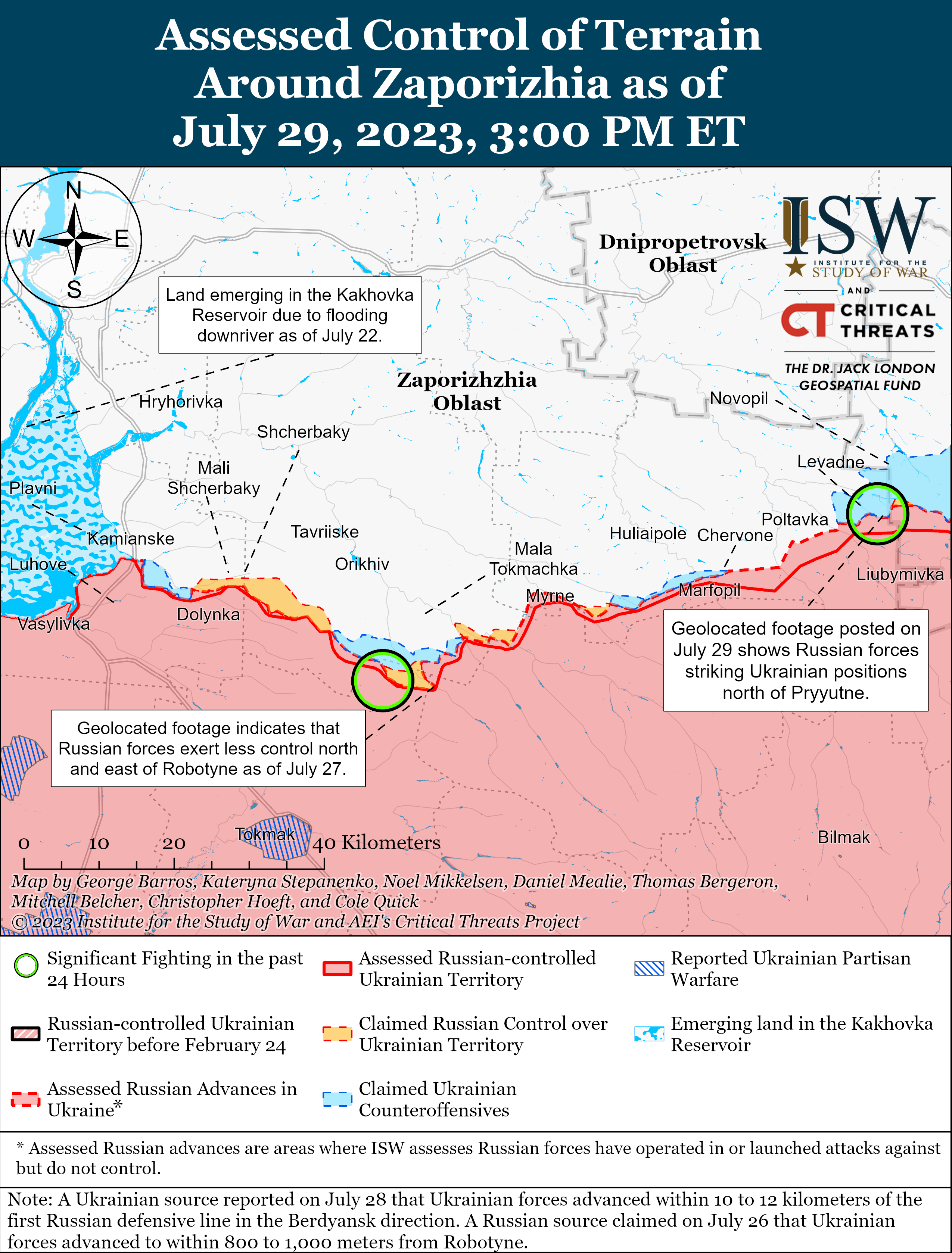Russian Offensive Campaign Assessment, July 29, 2023
AFGHANISTAN, July 29 - Russian Offensive Campaign Assessment, July 29, 2023
Riley Bailey, Grace Mappes, Nicole Wolkov, Angelica Evans, and Frederick W. Kagan
July 29, 2023, 3:40pm ET
Click here to see ISW’s interactive map of the Russian invasion of Ukraine. This map is updated daily alongside the static maps present in this report.
Click here to access ISW’s archive of interactive time-lapse maps of the Russian invasion of Ukraine. These maps complement the static control-of-terrain map that ISW produces daily by showing a dynamic frontline. ISW will update this time-lapse map archive monthly.
Note: The data cutoff for this product was 11:30am ET on July 29. ISW will cover subsequent reports in the July 30 Russian Offensive Campaign Assessment.
Segments of the Russian pro-war ultranationalist information space appear to be coalescing around the Kremlin’s narrative effort to portray the Ukrainian counteroffensive as a failure, increasingly overstating Ukrainian losses and writing less about Russia's losses and challenges than they had been. Prominent Russian milbloggers have been increasingly presenting Ukrainian counteroffensive operations inaccurately as a series of failed Ukrainian assaults along the entire line of contact.[1] Russian milbloggers widely amplified footage on July 29 claiming that it showed a single Russian tank defeating an entire Ukrainian company with armored vehicles as if the event had occurred recently, but the footage is actually from June 7 and shows Russian artillery units striking the Ukrainian column.[2] Russian sources have previously recirculated old footage to support claims that Ukrainian forces are suffering significant armored vehicle losses, and the amplification of the footage on July 29 indicates that Russian sources are deliberately amplifying old footage to support the Kremlin narrative.[3] Russian President Vladimir Putin recently claimed that Ukrainian forces lost 39 armored vehicles in a few days of fighting in western Zaporizhia Oblast, a notable inflection in his exaggeration of Ukrainian losses during the Ukrainian counteroffensive.[4] ISW previously assessed that the Kremlin is likely shifting its policy about the coverage of the war to downplay the possibilities of a successful Ukrainian counteroffensive and to promote itself as an effective manager of the war effort.[5] Russian milbloggers continue to report on localized Ukrainian advances and some issues with Russian defensive operations, but the pro-war Russian information space’s wider operational framing of the Ukrainian counteroffensive aligns with the likely shift in the Kremlin’s portrayal of the counteroffensive.[6]
Select Russian milbloggers may be shaping their depiction of the wider Ukrainian counteroffensive for fear of Kremlin punishment following the arrest of prominent pro-war critic Igor Girkin. A Russian insider source claimed on July 28 that sources within the presidential administration stated that the Kremlin recently encouraged Kremlin-affiliated milbloggers to reduce their coverage of the war in Ukraine in general and to post more positive content on topics of nationalistic pride.[7] ISW has not observed Kremlin-affiliated milbloggers reducing their coverage of the war, although Kremlin-affiliated milbloggers have begun to argue more emphatically that the Ukrainian counteroffensive is a failure.[8] The arrest of notable critics of the Russian war effort in Ukraine such as Girkin along with ongoing Russian Ministry of Defense (MoD) efforts to consolidate control over the Russian information space may be prompting select milbloggers to align their portrayal of the war with the Kremlin’s more than they have normally done.[9]
The Kremlin’s ability to establish a more cohesive narrative about the war within the Russian information space remains uncertain, and subsequent Russian failures or significant Ukrainian successes could disrupt the Kremlin’s progress in this effort. Segments of the Russian information space do continue to complain about systemic issues within the Russian war effort in Ukraine, and many Russian milbloggers would likely reverse course on their portrayal of the Ukrainian counteroffensive in the event of significant Ukrainian gains. The milblogger community continues to be highly reactive and motivated by salient topics of outrage, and many milbloggers would likely abandon efforts to align themselves with the Kremlin’s messaging about the war in the event that a controversy about Russian failure prompts renewed intense ire towards the Russian military leadership.[10] A cohesively amplified and unchallenged Kremlin narrative concerning the tactical and operational situation in Ukraine would make accurate coverage of battlefield realities more challenging, particularly in the absence of more detailed reporting from the Ukrainian side.
Ukrainian forces conducted counteroffensive operations on at least three sectors of the front and advanced in some areas on July 29. Geolocated footage published on July 28 confirms that Ukrainian forces have advanced close to the northwestern outskirts of Kurdyumivka (13km southwest of Bakhmut).[11] Geolocated footage published on July 29 shows that Ukrainian forces advanced to positions near the northern outskirts of Pryyutne (16km southwest of Velyka Novosilka) in the Donetsk-Zaporizhia Oblast border area.[12] Russian sources claimed that Ukrainian forces continued assaults near Klishchiivka, Kurdyumivka, and Andriivka south of Bakhmut.[13] Ukrainian officials reported that Ukrainian forces conducted counteroffensive operations in the Donetsk-Zaporizhia Oblast border area and in western Zaporizhia Oblast.[14] Russian sources claimed that Russian forces repelled Ukrainian ground attacks near Rivnopil, Staromayorske, and Urozhaine in the Donetsk-Zaporizhia Oblast border area.[15] Russian sources claimed that Ukrainian forces conducted unsuccessful ground attacks near Robotyne in western Zaporizhia Oblast, and one milblogger claimed that Ukrainian forces captured a forest northeast of Robotyne.[16] A Russian milblogger stated that Russian defensive fortifications will not matter if Ukrainian forces inflict heavy losses on Russian forces to the point that there are not enough Russian personnel to man the fortifications.[17] The milblogger also stated that the depth of Ukrainian advances into Russian defensive lines matters less than the degree to which the balance of forces has shifted to favor Ukraine during the course of the counteroffensive.
Ukrainian forces targeted Russian military and logistics assets in occupied Crimea on July 28 and 29. The Ukrainian Armed Forces reported that Ukrainian forces struck the Chonhar bridge between occupied Crimea and occupied Kherson Oblast on the morning of July 29.[18] Kherson Oblast occupation head Vladimir Saldo claimed Ukrainian forces launched 12 Storm Shadow missiles at the Chonhar rail bridge, but claimed that Russian air defenses intercepted all 12 missiles.[19] Some social media sources stated that locals reported explosions in the Chonhar area, but there is currently no visual evidence of the strike or claims about the consequences of the strike at the time of this publication.[20] The Ukrainian Main Military Intelligence Directorate (GUR) reported that saboteurs set explosives against a Russian ammunition depot in Kozacha Bay near Sevastopol, Crimea on July 28 and that locals reported primary and secondary detonations.[21] Sevastopol occupation head Mikhail Razvozhaev claimed on July 28 that any explosions in the Kozacha Bay area were due to Russian military exercises.[22]
Russian forces conducted a missile strike on Dnipro City, Dnipropetrovsk Oblast on the evening of July 28. Ukrainian President Volodymyr Zelensky and the Ukrainian General Staff reported that Russian forces struck a residential building and a Ukrainian Security Services (SBU) building in Dnipro City with two Iskander cruise missiles.[23]
Key Takeaways:
- Segments of the Russian pro-war ultranationalist information space appear to be coalescing around a Kremlin narrative effort to portray the Ukrainian counteroffensive as a failure, increasingly overstating Ukrainian losses and writing less about Russia's losses and challenges than they had been.
- Select Russian milbloggers may be shaping their depiction of the wider Ukrainian counteroffensive for fear of Kremlin punishment following the arrest of prominent pro-war critic Igor Girkin.
- The Kremlin’s ability to establish a more cohesive narrative about the war within the Russian information space remains uncertain, and subsequent Russian failures or significant Ukrainian successes could disrupt the Kremlin’s progress in this effort.
- Ukrainian forces conducted counteroffensive operations on at least three sectors of the front and advanced in some areas on July 29.
- Ukrainian forces likely targeted Russian military and logistics assets in occupied Crimea on July 28 and 29.
- Russian forces conducted a missile strike on Dnipro City, Dnipropetrovsk Oblast on the evening of July 28.
- Russian forces conducted offensive operations along the Svatove-Kreminna line and the Avdiivka-Donetsk City line and made claimed advances along the Svatove-Kreminna line.
- Ukrainian forces conducted offensive operations along the Svatove-Kreminna line, around Bakhmut, and along the Avdiivka-Donetsk City line and advanced around Bakhmut.
- Ukrainian forces conducted offensive operations along the western Donetsk-eastern Zaporizhia Oblast border area and south of Orikhiv and advanced along the western Donetsk-eastern Zaporizhia Oblast border area.
- Russian forces conducted offensive operations along the western Donetsk-eastern Zaporizhia Oblast border area and south of Orikhiv but did not make confirmed or claimed advances.
- A Ukrainian report indicates that Russian occupation authorities continue crypto-mobilization efforts in occupied Ukraine to replenish losses from combat casualties.
- Russian authorities continue to forcibly deport Ukrainian children in occupied Ukraine to Russia under the guise of rest and rehabilitation programs.
We do not report in detail on Russian war crimes because these activities are well-covered in Western media and do not directly affect the military operations we are assessing and forecasting. We will continue to evaluate and report on the effects of these criminal activities on the Ukrainian military and the Ukrainian population and specifically on combat in Ukrainian urban areas. We utterly condemn these Russian violations of the laws of armed conflict, Geneva Conventions, and humanity even though we do not describe them in these reports.
- Russian Main Effort – Eastern Ukraine (comprised of two subordinate main efforts)
- Russian Subordinate Main Effort #1 – Capture the remainder of Luhansk Oblast and push westward into eastern Kharkiv Oblast and encircle northern Donetsk Oblast
- Russian Subordinate Main Effort #2 – Capture the entirety of Donetsk Oblast
- Russian Supporting Effort – Southern Axis
- Russian Mobilization and Force Generation Efforts
- Activities in Russian-occupied areas
Russian Main Effort – Eastern Ukraine
Russian Subordinate Main Effort #1 – Luhansk Oblast (Russian objective: Capture the remainder of Luhansk Oblast and push westward into eastern Kharkiv Oblast and northern Donetsk Oblast)
Russian forces continued offensive operations along the Svatove-Kreminna line on July 29 and reportedly advanced in some areas. The Ukrainian General Staff reported that Russian forces conducted unsuccessful offensive operations near Novoyehorivka (16km southwest of Svatove), the Serebryanske forest area south of Kreminna, and Bilohorivka (12km south of Kreminna).[24] The Russian MoD claimed that elements of the Russian Western Grouping of Forces conducted offensive operations near Kuzemivka (15km northwest of Svatove).[25] A prominent Russian milblogger claimed that elements of the 21st Motorized Rifle Brigade (2nd Combined Arms Army, Central Military District) captured Novoyehorivka and are currently clearing surrounding areas.[26] The milblogger also claimed that Russian forces pushed Ukrainian forces from heights between Novoyehorivka and Nadiya (15km west of Svatove).[27] Another Russian milblogger claimed that Russian forces conducted assaults near Nadiya but did not specify the results.[28] ISW has not observed visual confirmation of recent Russian claims of extensive Russian advances along the Svatove-Kreminna, and the Russian MoD and select Russian milbloggers may be exaggerating claims of advances to draw attention from Ukrainian counteroffensives elsewhere.[29]
Russian sources claimed that Ukrainian forces conducted ground attacks along the Svatove-Kreminna line on July 29 and did not advance. The Russian MoD claimed that elements of the Russian Central Grouping of Forces repelled two Ukrainian assaults near Raihorodka (12km west of Svatove) and the Serebryanske forest area and that elements of the Russian Southern Grouping of Forces repelled a Ukrainian assault near Bilohorivka, Donetsk Oblast (33km south of Kreminna).[30]
Russian Subordinate Main Effort #2 – Donetsk Oblast (Russian Objective: Capture the entirety of Donetsk Oblast, the claimed territory of Russia’s proxies in Donbas)
Ukrainian forces continued counteroffensive operations near Bakhmut and advanced on July 29. Geolocated footage published on July 28 shows that Ukrainian forces advanced to the northwestern outskirts of Kurdyumivka (11km southwest of Bakhmut).[31] Russian milbloggers claimed that Ukrainian forces continued attacking Klishchiivka (7km southwest of Bakhmut) but that Russian defenses held.[32] A Russian milblogger claimed that Ukrainian forces reduced the intensity of their attacks against Klishchiivka due to bad weather in the area, and weather forecasts show limited rain near Klishchiivka during the morning of July 29.[33] Russian milbloggers claimed that Russian forces also repelled Ukrainian attacks near Andriivka (8km southwest of Bakhmut), Yahidne (2km north of Bakhmut), and Orikhovo-Vasylivka (11km northwest of Bakhmut).[34]
Russian and Ukrainian forces conducted limited offensive operations on the Avdiivka-Donetsk City line and did not advance on July 29. The Ukrainian General Staff and a Russian milblogger reported that Russian forces conducted ground attacks near Avdiivka and Marinka (immediately southwest of Donetsk City).[35] The Russian MoD claimed that Russian forces repelled Ukrainian ground attacks near Avdiivka, Pervomaiske (11km southwest of Avdiivka), and Krasnohorivka (immediately west of Donetsk City).[36]
Russian Supporting Effort – Southern Axis (Russian objective: Maintain frontline positions and secure rear areas against Ukrainian strikes)
Ukrainian forces continued counteroffensive operations along the western Donetsk-eastern Zaporizhia Oblast border area on July 29 and advanced in the area. Geolocated footage published on July 29 shows that Ukrainian forces advanced north of Pryyutne (14km southwest of Velyka Novosilka).[37] The Ukrainian General Staff reported that Ukrainian forces continued offensive operations in the Berdyansk (Donetsk-Zaporizhia Oblast area) direction.[38] The Russian MoD claimed that unspecified units of the Russian 36th Combined Arms Army (Eastern Ministry District) and Russian Airborne Forces (VDV) repelled two Ukrainian attacks near Staromayorske (9km south of Velyka Novosilka) and Urozhaine (9km south of Velyka Novosilka).[39] A Kremlin-affiliated milblogger claimed on July 29 that Ukrainian small infantry groups conducted unsuccessful attacks against Russian positions west of Staromayorske.[40]
Russian forces reportedly continued limited ground attacks along the western Donetsk-eastern Zaporizhia Oblast border area on July 29 and did not advance. Several Russian milbloggers claimed that Russian forces counterattacked near Rivnopil (10km southwest of Velyka Novosilka), Staromayorske, Urozhaine, and Pryyutne, but did not specify an outcome.[41] A Kremlin-affiliated milblogger claimed on July 29 that Russian forces are shelling Ukrainian positions in Staromayorske to prevent Ukrainian forces from advancing further south.[42]
Ukrainian forces continued counteroffensive operations in western Zaporizhia Oblast on July 29 and reportedly made marginal advances. The Ukrainian General Staff reported that Ukrainian forces continued offensive operations in the Melitopol (western Zaporizhia Oblast) direction.[43] Several milbloggers claimed that Ukrainian forces conducted assaults near Robotyne (10km south of Orikhiv) with artillery support but did not break through to the settlement.[44] A Kremlin-affiliated milblogger claimed that Ukrainian forces captured a small forest area northeast of Robotyne.[45]
Russian forces reportedly conducted a tactical rotation in place in western Zaporizhia Oblast on July 29.[46] A Russian milblogger claimed that Russian forces took advantage of a claimed lull in Ukrainian ground attacks near Robotyne due to poor weather to conduct engineering training and an unspecified force rotation.[47] While the milblogger did not provide details of the rotation, Russian forces likely conducted a tactical rotation in place with another unit of the same formation rather than rotating fresh units into the area as Ukrainian forces did recently.[48] A prominent Russian milblogger posted footage on July 29 claiming to show elements of the 292nd Self-Propelled Artillery Regiment (19th Motorized Rifle Division, Southern Military District) operating in the Zaporizhia direction.[49] Another milblogger posted footage indicating that unspecified elements of the Russian 810th Guards Naval Infantry Brigade (Black Sea Fleet) continue operating near Robotyne.[50] The 19th Motorized Rifle Division and the 810th Naval Infantry Brigade have been defending this area since the start of the counteroffensive.
Russian Mobilization and Force Generation Efforts (Russian objective: Expand combat power without conducting general mobilization)
A Ukrainian report indicates that Russian occupation authorities continue crypto-mobilization efforts in occupied Ukraine to replenish losses from combat casualties. The Ukrainian Resistance Center reported that Russian occupation authorities are forcing civilians in eastern and southern Ukraine to serve in Russian military units and that the Russian military command has staffed the 33rd “Margolev” Detachment with Ukrainians living in occupied territories.[51]
Activities in Russian-occupied areas (Russian objective: Consolidate administrative control of annexed areas; forcibly integrate Ukrainian civilians into Russian sociocultural, economic, military, and governance systems)
Russian authorities continue to forcibly deport Ukrainian children in occupied Ukraine to Russia under the guise of rest and rehabilitation programs. Kherson Oblast occupation administration amplified an announcement on July 26 that a second group of 40 children from Skadovsk Raion in occupied Kherson Oblast arrived at the Raduga Social and Rehabilitation Center for a 21-day rehabilitation course in Nalchik, Kabardino-Balkaria Republic.[52] The Kherson Oblast occupation administration claimed that the program will provide Ukrainian children with medical and psychological treatment and participate in sports and educational excursions in the Kabardino-Balkaria Republic.[53]
The Kremlin continues attempts to legitimize the Russian occupation authorities by including them in international discussions. Zaporizhia Oblast occupation head Yevgeny Balitsky reported on July 29 that Zaporizhia Oblast occupation State Unitary Enterprise State Grain Operator representatives met with unspecified African representatives at the Russia-Africa Summit in St Petersburg, Russia to establish the Crimean-African Business Council and discuss delivering grain from occupied Ukraine to African countries.[54]
Significant activity in Belarus (Russian efforts to increase its military presence in Belarus and further integrate Belarus into Russian-favorable frameworks and Wagner Group activity in Belarus).
Polish Prime Minister Mateusz Morawiecki stated on July 29 that over 100 Wagner Group personnel have moved to northwestern Belarus near the Suwalki Corridor (the border between Poland and Lithuania that separates Belarus from Kaliningrad, Russia).[55] Morawiecki reported that Wagner forces may pose as Belarusian border guards to help migrants cross into the EU or themselves pose as migrants to enter the EU.[56] A Wagner-affiliated source claimed that Wagner forces may be training with Belarusian forces at the 6th Separate Mechanized Brigade training ground in Grodno and that Wagner and Belarusian forces will jointly train until at least August 6.[57] Wagner forces have been in Belarus since at least July 14 when the Belarusian Ministry of Defense (MoD) confirmed that Wagner instructors were training Belarusian forces near Asipovichy, Mogilev Oblast.[58]
ISW will continue to report daily observed Russian and Belarusian military activity in Belarus, as part of ongoing Kremlin efforts to increase their control over Belarus and other Russian actions in Belarus.
Note: ISW does not receive any classified material from any source, uses only publicly available information, and draws extensively on Russian, Ukrainian, and Western reporting and social media as well as commercially available satellite imagery and other geospatial data as the basis for these reports. References to all sources used are provided in the endnotes of each update.
Legal Disclaimer:
EIN Presswire provides this news content "as is" without warranty of any kind. We do not accept any responsibility or liability for the accuracy, content, images, videos, licenses, completeness, legality, or reliability of the information contained in this article. If you have any complaints or copyright issues related to this article, kindly contact the author above.








